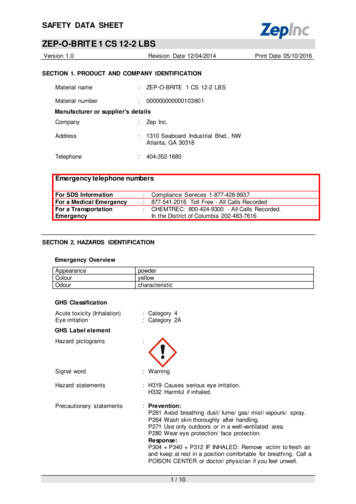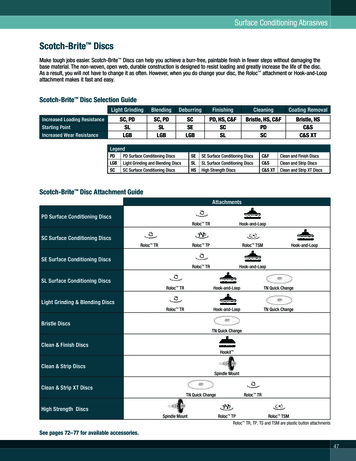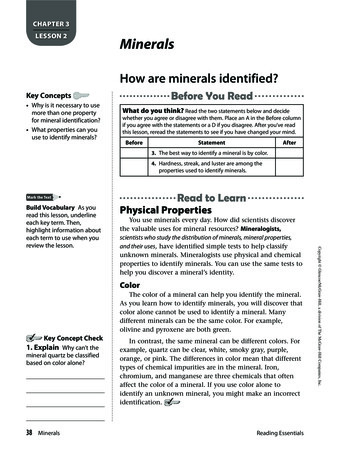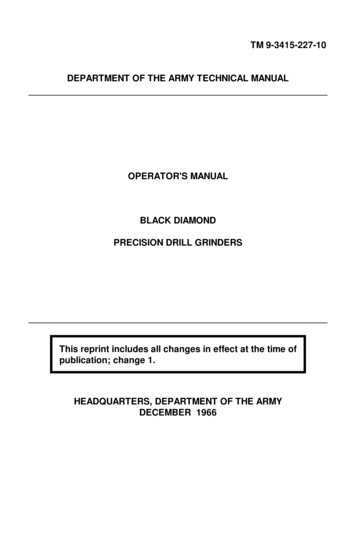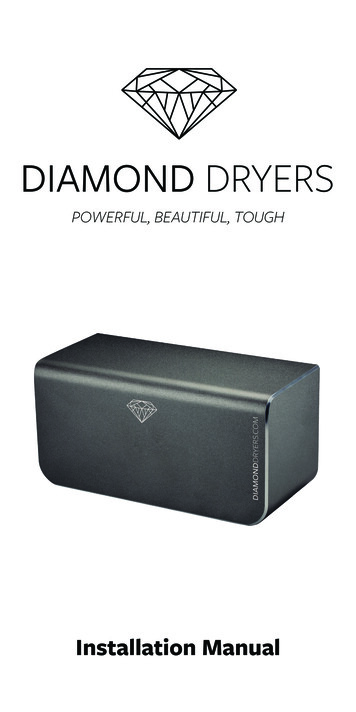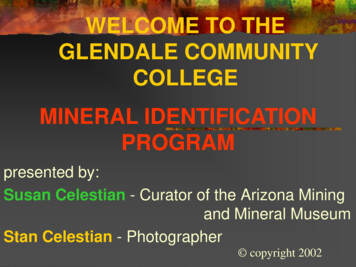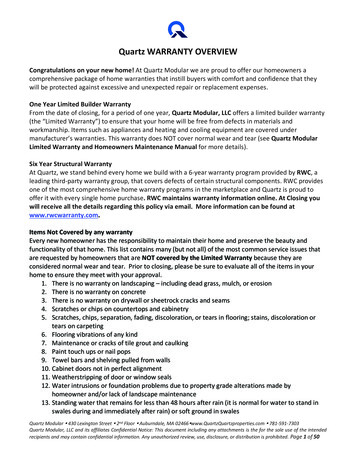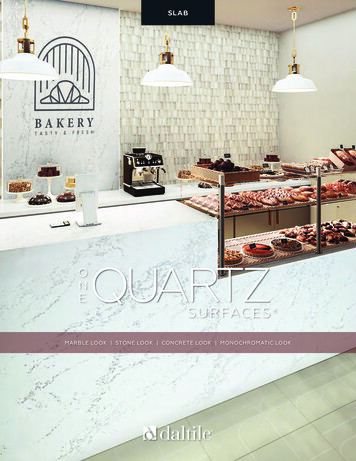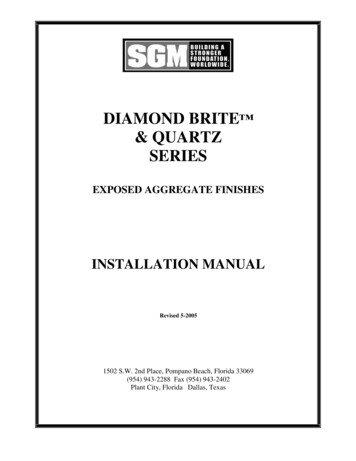
Transcription
DIAMOND BRITE & QUARTZSERIESEXPOSED AGGREGATE FINISHESINSTALLATION MANUALRevised 5-20051502 S.W. 2nd Place, Pompano Beach, Florida 33069(954) 943-2288 Fax (954) 943-2402Plant City, Florida Dallas, Texas
INTRODUCTIONDiamond Briteis an exceptionally durable swimming pool and spa finish that is a uniqueblend of quartz aggregate, insoluble coated Diamond Quartz and polymer modified cement. Itwas developed to answer both the consumer and contractor’s demand for a longer lasting andmore colorful pool finish that is resistant to traditional plaster problems. Diamond Brite will standup to the harshest pool environments and can be cleaned by acid washing several timesthroughout its life span, without sustaining permanent damage.In the late 1980’s spot etching and other plaster problems had reached epidemic proportionthroughout the United States. Traditional limestone-based finishes deteriorated rapidly, evenwith reasonable chemical maintenance, leading to customer dissatisfaction and frustration forcontractors. This rapid deterioration was due to the weak, soluble nature of the marbleaggregate and fine cement paste at the plaster surface. The dissolution of the cement paste andsubsequent erosion of the marble aggregate produced unsightly “spot etching” and discoloration.Minute fluctuations in water chemistry were sufficient to initiate the unstoppable process ofdeterioration that afflicted many pools and spas.Typical cleaning methods such as “acidwashing” brought only temporary relief and in reality caused accelerated erosion. More than afew pool builders and service contractors went out of the plaster business as a result of theseproblems.Finally, in the early 1990s, SGM introduced Diamond Brite to the swimming pool and spaindustry. With its revolutionary use of insoluble quartz and exposed aggregate technology,Diamond Brite quickly took the industry by storm. Pool and spa contractors everywhere eagerlyembraced Diamond Brite as a true advancement over existing pool plaster technology.Over the last 15 years hundreds of thousands of Diamond Brite pools have been installed,including major water theme parks, international resorts, competition, commercial and residentialpools and spas throughout the world.There is no secret to Diamond Brite’s success. Quartz aggregate, unlike marble, is completelyinsoluble, even in the presence of highly corrosive acid. And, by intentionally removing the highlysusceptible cement paste during the exposure process, a colorful, slip resistant and extraordinarydurable surface is revealed. Finally, polymer modification of the cement used in Diamond Brite,increases hardness, improves bonding and reduces water penetration.Careful selection of the finest ingredients available and strict quality control procedures set SGMapart from all other manufacturers. Every batch of Diamond Brite, about 60 to 80 bags, producedat SGM manufacturing facilities in Pompano Beach Florida, Plant City Florida, Dallas Texas, andCorona California, is tested before shipping to insure our customers receive the highest qualityproduct. Samples of each batch are stored at the factory for future reference in the event of awarranty claim.Finally, this manual is intended as a reference source only. It is assumed that the user isexperienced in the application of standard swimming pool plasters and water chemistry. There isno substitute for hands-on experience in the application of Diamond Brite. Training by skilledinstallers is available through SGM and is the preferred way to acquire the necessary skills.Revisions will be published yearly as more information is accumulated. For more information orto get on our mailing list to receive a revised copy each year, contact your local SGMrepresentative or call us at (800) 641-9247.2
I.DETERMINING COVERAGEA.Measure the total square footage of the pool’s interior surface (walls and floor). Includeextra material for steps, benches and swim outs.B.Under ideal conditions use 25 square feet per bag to calculate number of bags, resurfaceprojects use 22 square feet per bag as a cushion for variations. More material will berequired for a rougher shell. Use 18 square feet per bag for Pearl and Golden Pearl dueto the larger aggregate size.C.Always add 5% to 10% more bags to allow for error. It will not be possible to matchareas plastered later due to shortages on the job site. Always take more material thanyou need.II.PREPARATION OF THE SUBSTRATE OR POOL SHELLA.New Pool Shells1.The shell must be free of any foreign material that may interfere with the bonding of thenew plaster.2.All loose material such as dripped thin-set, grout, paint, dirt, patching or decking productsmust be removed by scraping, water blasting (pressure cleaning) or sand blasting.3.Algae, mold and mildew must be eliminated by chlorine washing. Failure to do so willresult in discoloration and bond failure (delaminations).4.Remove any oil or grease with tri-sodium phosphate and water. Oils and grease left onthe pool shell will cause bond failure and prevent proper etching and cleaning bywaterborne acid solutions. To test for oil and grease, wet the entire pool shell surfaceand examine it carefully for beading water droplets. Heavily saturated areas may requiresoaking with liquid detergents until oil is removed.5.Etch the surface with Muriatic Acid and water. Adjust the concentration as needed toproperly clean and roughen the surface.Smoother shells will require a higherconcentration of acid and vice versa.6.All water penetration due to hydrostatic pressure (weepers) must be stopped. Use SGMInstant Hydraulic Cement to plug leaks and seal around fittings.7.The shell must be fully cured at least 28 days.8.All pool inlets and main drain lines should be plugged to prevent clogging duringplasterwork and exposure. All plugs except the main drain should remain in place untilthe pool is filled to prevent drip stains.9.Mark the location of all fittings with a small piece of tape placed on the coping directlyabove to prevent them from being accidentally covered during the plaster process. Itmay be best to draw a map indicating the locations of all fittings in projects withnumerous inlets and outlets.B.Resurfacing Projects1.Follow all of the above procedures.2.Undercut all existing tile and fittings 2” away and 3/8” deep into the existing plaster substrate.3.Sound out and remove all hollow and delaminated plaster. Identify the hollow spots andsaw an area 3” outside them. Remove the loose plaster inside the cut area.3
4.Fill the hollow with SGM Sand Topping Mix or a plaster mixture and Concrete BondingAgent bringing the area level with the existing plaster.5.Apply SGM Bond Kote as directed. Each unit of Bond Kote consists of one 5-gallon pailof Liquid Resin and two 65 lb., bags of Dry Mix and will cover approximately 500 squarefeet. Mix one 65 lb. bag of SGM Bond Kote with 1/2 pail of SGM Bond Kote Liquid Resin.Coat the existing plaster using a 1 1/4” nap paint roller.Allow material to set for one minute then create stipple texture by going over the areaagain with roller. Allow Bond Kote to cure for at least 6 hours before plastering. If BondKote is rained on or left to sit for more than a few days it may have to be reapplied.III.MIXINGNote:Diamond Brite is made in batches of 60 to 80 bags using natural ingredients. For thisreason there will be variations in shade between batches. Batch numbers are stampedon the ends of every bag. It is incumbent upon the user to follow these instructionsexplicitly to ensure the most consistent color throughout the pool.A.Separate the bags according to the batch numbers stamped on the bottom of each bag.Record all batch numbers. All warranties are rendered invalid without the batchnumbers.B.Blend different batches together in each mix according to the ratio present at the job site.For example: If there are 30 bags total on the job and there are 20 bags of Batch A and10 bags of Batch B then use 2 bags of A to 1 bag of B in every mix.C.Measure and add water to mixer. Hold back a portion of the water and add as necessaryas mixing progresses. Careful measuring of the mix water will produce the best material.Lower water to cement ratios will produce plaster of greater strength and density. It istherefore best to use as little water as needed to produce a workable mix. Excess waterwill reduce strength and increase shrinkage (check) cracks. Water requirements will varyaccording to job site conditions.Note:Mix water quality is extremely important. Well water or water high in metal and mineralcontent will cause discoloration in finished Diamond Brite. Additionally, water of highhardness or alkalinity will cause the plaster to effloresce, releasing high levels of saltsthat produce calcium scale. This is especially true of colored Diamond Brite such asMidnight Blue, Onyx, Tahoe Blue and French Gray. Check mix water for metals,minerals, hardness and alkalinity before using.D.Start mixer and add Diamond Brite as quickly as possible to ensure that all the materialhas the proper mix time. Failure to do so will produce uneven set times and result inwashouts and streaking.E.Mix for a minimum of 5 minutes but no more than 10 minutes. This ensures evendistribution of aggregates and increases the working time of the plaster. Insufficient mixtime will result in uneven setting and shade variations. Too much mix time will producean overall weaker plaster and may entrain undesirable air bubbles. As a rule of thumb,mix for only the amount of time required to produce a consistent, homogenous batter.F.Calcium Chloride may be used as an accelerator. It must be fully dissolved in waterallowing impurities to settle out. Pour off the solution from the top being careful not to addimpurities to the mix. The impurities found in calcium chloride flake and pellets havebeen known to cause discoloration in pool plaster. No more than 2% by weight ofcement (about 1/2 lb. per bag) can be used. Overuse will cause discoloration. For bestresults use SGM Accelerator 100 at a maximum rate of 1/4 gallon per bag.4
IV. PUMPINGNote:Although it is not necessary to use a plaster pump many contractors do. Included hereare some helpful hints for successful pumping.A.Increase the size of the pump manifold from 3” to 4”. This can be expensive and not allplasterers have found it necessary. Change the valve ball from plastic to steel to improvelongevity.B.Set plaster pump to the lowest gear by moving the belt. Always begin pumping with a fullstroke on the main piston. This is accomplished by advancing the wheel until the cam isat its highest position.B.Prepare a slurry of cement and water and run it through the pump first to prime the pumpand lubricate the hoses. A pump aid can be used as directed.C.Pour the mixed plaster slowly into the pump hopper. Do not pour all the material in atonce. Agitate the material in the hopper to prevent separation of the cement andaggregate.D.Pump the complete batch without stopping. Avoid unnecessary stopping during thepumping process. Diamond Brite aggregate will tend to settle in the pump manifold andhoses when the pump is stopped.E.Do not try to clear a jam using the pump. Disassemble and clean the manifold and hoseswhen clogged. Do not water down mix. This will only cause the material to separate,clogging the pump and hoses.V.APPLICATIONA.Substrate should be cool and damp but not dripping wet. Mist the shell with cool, cleanwater but do not leave standing water. Standing water will weaken Diamond Brite inisolated areas and cause washouts.Note:Hot, dry shells will cause rapid setting of the plaster and result in check or shrinkagecracking and delamination.B.Discard unmixed material (lumps). Breaking up and troweling in lumps changes the setof the Diamond Brite in that spot. This will also create a weak spot and cause washouts.C.Apply a scratch coat to the bowl first. The bowl will set up last and it will be necessary towalk on the bowl during the exposure process.D.Beginning with the shady walls and working to the sunny walls trowel a scratch coat onthe walls and allow to set-up slightly. The set time will vary according to temperature andhumidity so constant inspection of the plaster during the set time is essential.E.Apply a finish coat to the entire pool surface working to 3/8” - 1/2” thick. Careful trowelingwill help to ensure even exposure, reduce washouts and produce a comfortable slipresistant finish. The technique of “Slick Troweling” is recommended. In this process thecement paste is brought to the surface during troweling and is removed with the trowel.This produces a slick surface and minimized the exposure needed. The aggregate canbe seen through a thin film of cement paste after toweling is complete.5
F.Special attention must be given to the filling in of shoe spike holes. Troweling in thepaste from the surface will result in the hole having no aggregate. The applicator mustbe careful to fill all spike holes with Diamond Brite aggregate to avoid visible spike holes.G.Extra care must be taken to ensure proper troweling in the coves and corners.Insufficient troweling in these areas will result in roughness and washouts (loss ofcement and aggregate) during the exposure process.VI.EXPOSURENote:You must have one workman for every 300 square feet to properly expose DiamondBrite. The exposure time is limited to approximately one hour but will vary according tolocal conditions. Beginning too early or too late will result in uneven exposure. Someareas may be ready for exposure while other areas are still being troweled. Constantinspection of the Diamond Brite for readiness is imperative.There are several techniques commonly used to expose Diamond Brite. The following isa list of the most popular techniques.A.Water Washing With BrushesNote:This is by far the most effective technique and produces the best results with standardDiamond Brite Finishes. It is not recommended for the Diamond Brite QuartzSeries Finishes.1.When the Diamond Brite has lost its sheen or is no longer damp, it may be ready forexposure with soft bristle brushes and water. The material must be sufficiently set up toallow applicators to walk on the floor without leaving footprints. Wear white cotton socksor foam shoes when exposing Diamond Brite.Boots and bare feet are notrecommended.2.Test the plaster for readiness by carefully washing a small area with a soft bristle brush.If the cream washes away without losing aggregate the exposure process may begin.3.Starting with sunny or fast setting areas begin washing away cement paste with waterand brushes. Use a bucket first then progress to a soft flow of water from a garden hoseas the material begins to harden. Begin using stiff bristle brushes as the set progresses.4.Examine the plaster for hot spots that may be setting quickly. Mist these areas withwater to allow longer exposure time. Over-cured cement paste will not remove easilyand may require stiff bristle brushes to remove. Avoid slow setting areas like shady wallsand the bowl. Washing too soon in these areas will cause washouts. If an area washesout it must be re-troweled immediately. Keep some extra Diamond Brite mixed up foruse in patching washout areas. Use of torches or newspaper to dry wet areas isacceptable if done properly.5.Keep a sump pump running in the main drain at all times to discharge the wash solution.Dispose of wash as directed by local requirements.6.Avoid leaving hoses, buckets or any other items on the plaster during exposure. Anyobject left on the plaster during this critical phase may leave a “shadow” on the surface.In the event of shadowing heat may be carefully applied to remove the discoloration.6
7.When all of the cement paste has been removed from the surface uniformly, the brushphase is complete. If done thoroughly, this will complete the exposure process. Theprocess of acid washing as described below is optional.8.If desired, an acid wash may now be performed using a 25% solution of Muriatic Acid(higher concentrations may be needed for stubborn areas) and water to remove the thinfilm that may remain on the surface. Proper safety equipment must be worn at all times.Begin washing the bowl first and work up to the shallow end. Following this procedurewill minimize “rivers” or streaks on the floor. The use of an acid wash additive to reducefumes and ensure uniform coverage is highly recommended. Neutralize and discard thewash solution according to local requirements.Neutralize acid remaining on theDiamond Brite with Soda Ash and water to avoid discoloration.B.Acid WashingNote:This technique is commonly used in cold climates or when the plasterers lack sufficientexperience to undertake water washing. It is easier to do but can produce a less uniformfinish. Use this technique when applying the Quartz Series.1.After troweling, allow the plaster to fully set up. This may take anywhere from one to afew hours or overnight, depending on local jobsite conditions.2.Begin acid washing by using a 25% solution of Muriatic Acid (higher concentrations maybe needed for stubborn areas) and water to remove the cement film that may remain onthe surface. Increase the concentration of the acid solution as needed. Proper safetyequipment must be worn at all times. Begin washing the bowl first and work up to theshallow end. Following this procedure will minimize “rivers” or streaks on the floor. Acidwash walls and steps last. Do not allow acid wash solution to puddle in the bowl area.Use a sump pump to constantly discard the run off after it is diluted and neutralized.3.The use of an acid wash additive to reduce fumes and ensure uniform coverage is highlyrecommended.Neutralize and discard the wash solution according to localrequirements. Neutralize acid remaining on the Diamond Brite with Soda Ash and waterto avoid discoloration.C.Wet Acid Wash.Note:Also called Acid Start-up or No Drain Acid wash. This technique is sometimes used afterwater washing. It is also used in areas where the fill water is high in alkalinity and orhardness. When used alone without water washing this technique produces the leastdesirable results. It will not remove all of the cement paste evenly and will result in astreaked appearance.1.Remove all metal such as ladders and lights from the pool and turn off the circulationsystem. If the ladder cannot be removed slip a plastic garbage bag over it to protect itfrom the acid.2.After filling the pool test the alkalinity to determine the amount of Muriatic acid needed tolower the Total Alkalinity to zero.3.Distribute the acid evenly throughout the pool.4.Brush the pool thoroughly over the entire surface twice daily for 3 days.5.Add a sequestering agent and raise the pH to the proper level with Soda Ash.6.Start the circulation system and follow the start-up instructions7
VII. STARTUP AND WATER BALANCEA.Pre-filter the water with a carbon or resin tank to eliminate stain-causing contaminants.B.First day, add a sequestering agent upon initial fill and maintain water circulation for 24hours prior to the balancing the pool chemistry. Adjust pH to 7.2 – 7.4.C.Second Day, Record the chlorine, pH, and total alkalinity, calcium hardness andtemperature levels. Adjust pH to 7.4 – 7.6 and the total alkalinity to 80 – 120 PPM.Dissolve all chemicals in water first and allow sufficient time for each chemical to be fullydispersed before adding the other chemicals. Do not add CHLORINE or CALCIUMCHLORIDE. Brush the entire surface twice a day for three (3) days.D.Third day, repeat steps from second day and adjust chemistry to the following levels:Free chlorine: 1.0 - 3.0 PPMpH: 7.4 – 7.6Total Alkalinity: 120 PPMCalcium Hardness: 200 PPM* Stabilizer: 30PPM*Note: Lower Calcium levels help to reduce scale and discoloration.E.Adjust the pump timer to normal operating hours.F.Do not install automatic pool cleaners for 28 days.G.Do not vacuum the pool with a wheeled vacuum for 14 days, to avoid leaving “wheelmarks”. Brush type vacuums may be used immediately.h.Brush pool walls and floor daily for the first 2 weeks.Note:These suggested guidelines are based on feedback from our customers throughout thenation. They represent an average of what has worked best for the majority and do notguarantee that you will not experience common plaster phenomenon such as staining,mottling, efflorescence and scale. Water supplies vary from one municipality to the nextand therefore commonsense, experience and good testing procedures must be followed.Refer to the N.S.P.I. guidelines on start-up and chemistry for more detailed information.VIII. COLORED PLASTERAll pool plasters are subject to shade variations, mottling, scale and efflorescenceproblems.Colored or pigmented pool plasters are especially prone to thesecharacteristics. Diamond Brite is no exception. We recommend the use of a “ColoredPlaster Release” when installing Midnight Blue, Onyx, French Gray, Tahoe Blue and otherpigmented Diamond Brite colors. This document should advise the customer of thenature of colored plasters thereby avoiding future conflicts.VIII. USE OF DIAMOND BRITE ABOVE WATERA.Diamond Brite has been used in place of waterline tile, in fountains, waterfalls, negativeedge pools, zero depth and beach entry applications where a more durable plaster isrequired. It should be understood by the customer that the Diamond Brite above thewater will have a dry appearance that differs from the plaster below water. Some checkcracking may occur. Whenever possible water curing of exposed areas for 7 to 28 dayswill lessen the occurrence of shrinkage cracking and increase overall strength of theplaster.8
B.Any blisters due to air trapped during troweling will fill with water and may delaminateduring freezing temperatures due to the expansion of frozen water. It is thereforeimperative that the Diamond Brite be free of any blisters in above water applications.C.Diamond Brite is not impervious to water penetration and will therefore develop a waterline ring due to the presence of oils and dirt at the water line that will require regularmaintenance.IX.MISCELLANEOUSA.Recommended reading from the National Spa and Pool Institute (703) 838-0083: “PoolPlaster Technology”.B.Recommended reading from the National Plasterers Council (714) 459-8053:Start-up Do’s & Don’ts for Newly Plastered Swimming Pools; Why You ShouldUse Plaster in Your Swimming Pool; Care Tips for New Swimming Pool Plasterand Technical Manual.9
Diamond Brite is an exceptionally durable swimming pool and spa finish that is a unique blend of quartz aggregate, insoluble coated Diamond Quartz and polymer modified cement. It was developed to answer both the consumer and contractor's demand for a longer lasting and more colorful pool finish that is resistant to traditional plaster problems.
